Detailed Report on Human Resource Management Practices at HSBC Bank
VerifiedAdded on 2022/12/28
|13
|3864
|90
Report
AI Summary
This report provides a comprehensive analysis of Human Resource Management (HRM) practices at HSBC, a multinational investment bank. It explores the purpose and functions of HRM in workforce planning, highlighting the impact of Brexit. The report examines the strengths and weaknesses of internal and external recruitment methods, assessing their implications for the organization. It also details the benefits of various HRM practices, such as training, recruitment, and reward systems, for both employers and employees. Furthermore, the analysis delves into how different HRM strategies influence the profit and productivity of HSBC, including employee monitoring, training, and development. The importance of employee relations and engagement in HRM decision-making is also discussed, along with an overview of relevant employee legislation and its impact. The report concludes with a summary of key findings and recommendations for optimizing HRM strategies at HSBC.
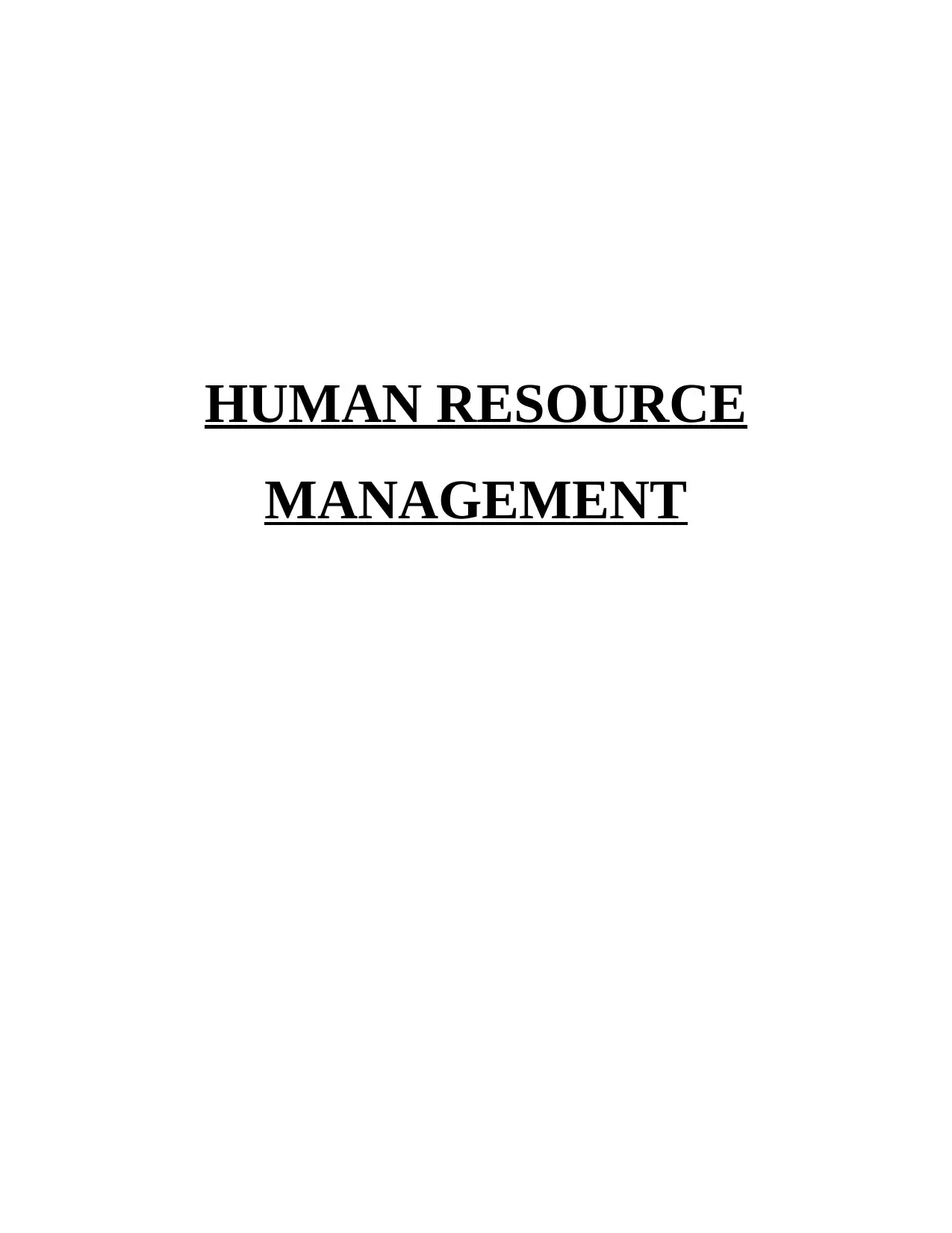
HUMAN RESOURCE
MANAGEMENT
MANAGEMENT
Paraphrase This Document
Need a fresh take? Get an instant paraphrase of this document with our AI Paraphraser

Table of Contents
INTRODUCTION...........................................................................................................................4
MAIN BODY...................................................................................................................................4
1 Purpose and functions of HRM applicable to workforce planning...........................................4
2 Strengths and weakness of approaches to recruitment and selection.......................................5
3 Benefits of different HRM practices in the organization for the employer and employee.......6
4:Analysation of different practices of HRM that effects profit or productivity of organisation.
......................................................................................................................................................7
5:Analysation of relations of employees that influence the HRM Decision making..................8
6:Elements of employee legislation and its impact on HRM decision-making...........................9
CONCLUSION..............................................................................................................................11
REFERENCES..............................................................................................................................13
INTRODUCTION...........................................................................................................................4
MAIN BODY...................................................................................................................................4
1 Purpose and functions of HRM applicable to workforce planning...........................................4
2 Strengths and weakness of approaches to recruitment and selection.......................................5
3 Benefits of different HRM practices in the organization for the employer and employee.......6
4:Analysation of different practices of HRM that effects profit or productivity of organisation.
......................................................................................................................................................7
5:Analysation of relations of employees that influence the HRM Decision making..................8
6:Elements of employee legislation and its impact on HRM decision-making...........................9
CONCLUSION..............................................................................................................................11
REFERENCES..............................................................................................................................13
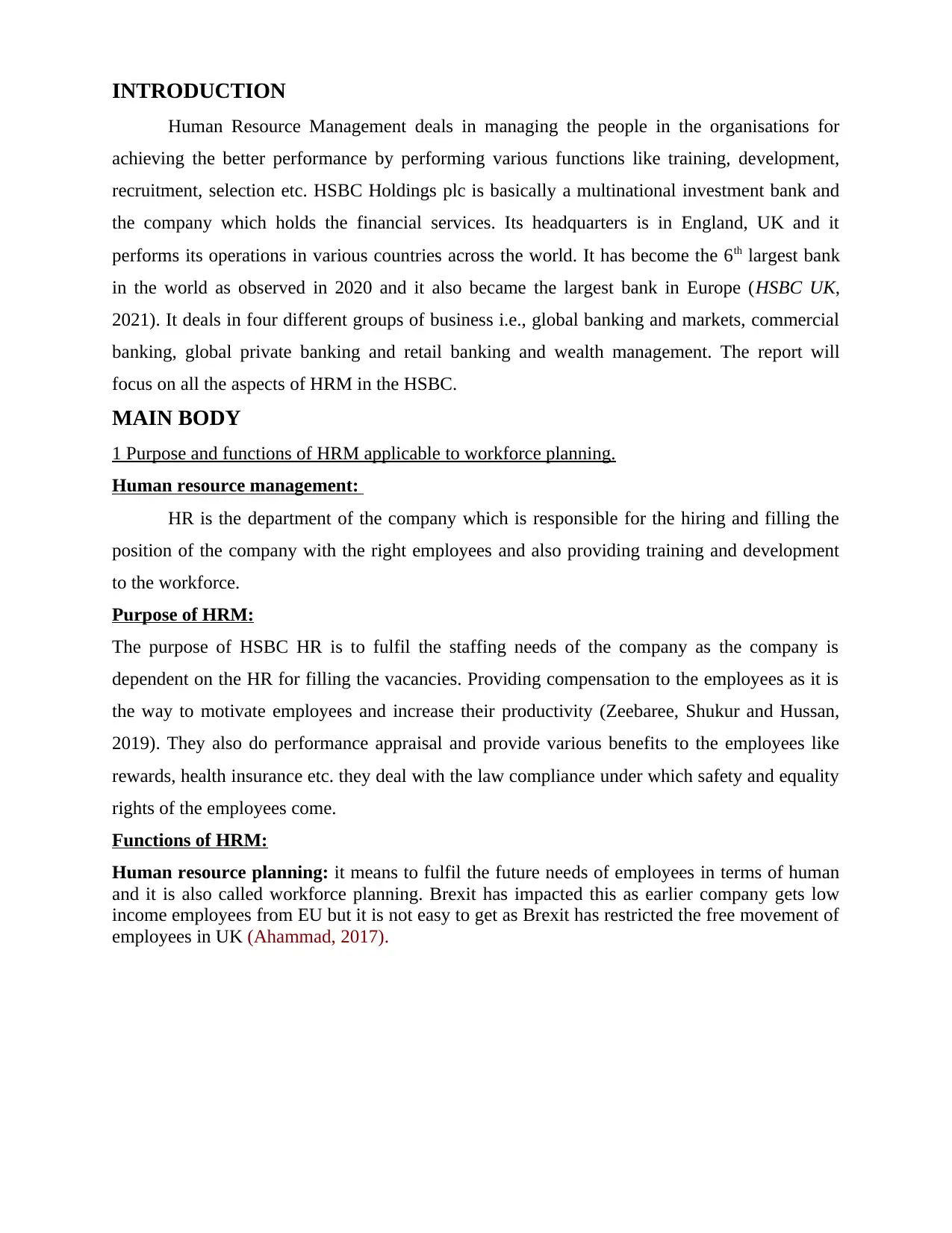
INTRODUCTION
Human Resource Management deals in managing the people in the organisations for
achieving the better performance by performing various functions like training, development,
recruitment, selection etc. HSBC Holdings plc is basically a multinational investment bank and
the company which holds the financial services. Its headquarters is in England, UK and it
performs its operations in various countries across the world. It has become the 6th largest bank
in the world as observed in 2020 and it also became the largest bank in Europe (HSBC UK,
2021). It deals in four different groups of business i.e., global banking and markets, commercial
banking, global private banking and retail banking and wealth management. The report will
focus on all the aspects of HRM in the HSBC.
MAIN BODY
1 Purpose and functions of HRM applicable to workforce planning.
Human resource management:
HR is the department of the company which is responsible for the hiring and filling the
position of the company with the right employees and also providing training and development
to the workforce.
Purpose of HRM:
The purpose of HSBC HR is to fulfil the staffing needs of the company as the company is
dependent on the HR for filling the vacancies. Providing compensation to the employees as it is
the way to motivate employees and increase their productivity (Zeebaree, Shukur and Hussan,
2019). They also do performance appraisal and provide various benefits to the employees like
rewards, health insurance etc. they deal with the law compliance under which safety and equality
rights of the employees come.
Functions of HRM:
Human resource planning: it means to fulfil the future needs of employees in terms of human
and it is also called workforce planning. Brexit has impacted this as earlier company gets low
income employees from EU but it is not easy to get as Brexit has restricted the free movement of
employees in UK (Ahammad, 2017).
Human Resource Management deals in managing the people in the organisations for
achieving the better performance by performing various functions like training, development,
recruitment, selection etc. HSBC Holdings plc is basically a multinational investment bank and
the company which holds the financial services. Its headquarters is in England, UK and it
performs its operations in various countries across the world. It has become the 6th largest bank
in the world as observed in 2020 and it also became the largest bank in Europe (HSBC UK,
2021). It deals in four different groups of business i.e., global banking and markets, commercial
banking, global private banking and retail banking and wealth management. The report will
focus on all the aspects of HRM in the HSBC.
MAIN BODY
1 Purpose and functions of HRM applicable to workforce planning.
Human resource management:
HR is the department of the company which is responsible for the hiring and filling the
position of the company with the right employees and also providing training and development
to the workforce.
Purpose of HRM:
The purpose of HSBC HR is to fulfil the staffing needs of the company as the company is
dependent on the HR for filling the vacancies. Providing compensation to the employees as it is
the way to motivate employees and increase their productivity (Zeebaree, Shukur and Hussan,
2019). They also do performance appraisal and provide various benefits to the employees like
rewards, health insurance etc. they deal with the law compliance under which safety and equality
rights of the employees come.
Functions of HRM:
Human resource planning: it means to fulfil the future needs of employees in terms of human
and it is also called workforce planning. Brexit has impacted this as earlier company gets low
income employees from EU but it is not easy to get as Brexit has restricted the free movement of
employees in UK (Ahammad, 2017).
⊘ This is a preview!⊘
Do you want full access?
Subscribe today to unlock all pages.

Trusted by 1+ million students worldwide
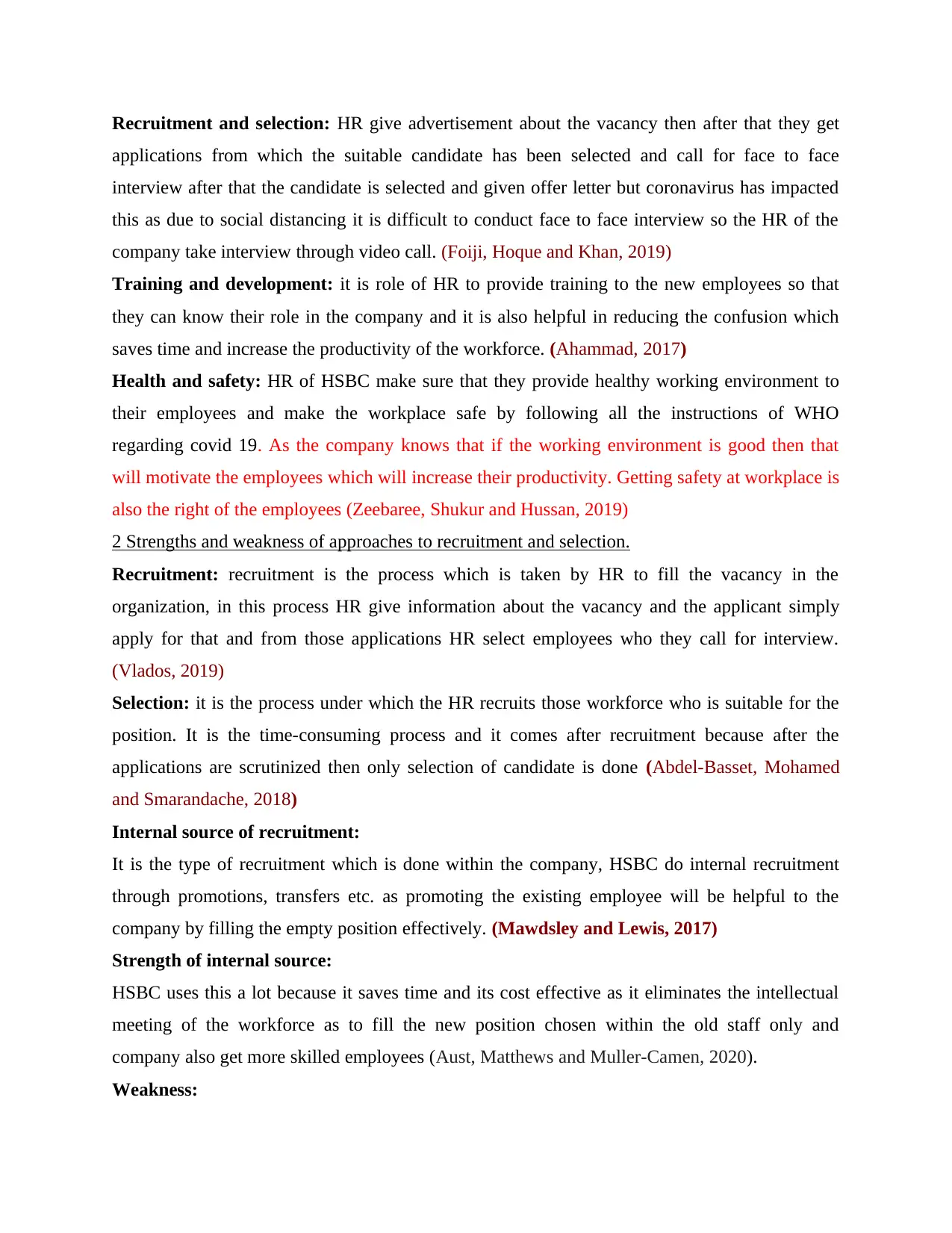
Recruitment and selection: HR give advertisement about the vacancy then after that they get
applications from which the suitable candidate has been selected and call for face to face
interview after that the candidate is selected and given offer letter but coronavirus has impacted
this as due to social distancing it is difficult to conduct face to face interview so the HR of the
company take interview through video call. (Foiji, Hoque and Khan, 2019)
Training and development: it is role of HR to provide training to the new employees so that
they can know their role in the company and it is also helpful in reducing the confusion which
saves time and increase the productivity of the workforce. (Ahammad, 2017)
Health and safety: HR of HSBC make sure that they provide healthy working environment to
their employees and make the workplace safe by following all the instructions of WHO
regarding covid 19. As the company knows that if the working environment is good then that
will motivate the employees which will increase their productivity. Getting safety at workplace is
also the right of the employees (Zeebaree, Shukur and Hussan, 2019)
2 Strengths and weakness of approaches to recruitment and selection.
Recruitment: recruitment is the process which is taken by HR to fill the vacancy in the
organization, in this process HR give information about the vacancy and the applicant simply
apply for that and from those applications HR select employees who they call for interview.
(Vlados, 2019)
Selection: it is the process under which the HR recruits those workforce who is suitable for the
position. It is the time-consuming process and it comes after recruitment because after the
applications are scrutinized then only selection of candidate is done (Abdel-Basset, Mohamed
and Smarandache, 2018)
Internal source of recruitment:
It is the type of recruitment which is done within the company, HSBC do internal recruitment
through promotions, transfers etc. as promoting the existing employee will be helpful to the
company by filling the empty position effectively. (Mawdsley and Lewis, 2017)
Strength of internal source:
HSBC uses this a lot because it saves time and its cost effective as it eliminates the intellectual
meeting of the workforce as to fill the new position chosen within the old staff only and
company also get more skilled employees (Aust, Matthews and Muller-Camen, 2020).
Weakness:
applications from which the suitable candidate has been selected and call for face to face
interview after that the candidate is selected and given offer letter but coronavirus has impacted
this as due to social distancing it is difficult to conduct face to face interview so the HR of the
company take interview through video call. (Foiji, Hoque and Khan, 2019)
Training and development: it is role of HR to provide training to the new employees so that
they can know their role in the company and it is also helpful in reducing the confusion which
saves time and increase the productivity of the workforce. (Ahammad, 2017)
Health and safety: HR of HSBC make sure that they provide healthy working environment to
their employees and make the workplace safe by following all the instructions of WHO
regarding covid 19. As the company knows that if the working environment is good then that
will motivate the employees which will increase their productivity. Getting safety at workplace is
also the right of the employees (Zeebaree, Shukur and Hussan, 2019)
2 Strengths and weakness of approaches to recruitment and selection.
Recruitment: recruitment is the process which is taken by HR to fill the vacancy in the
organization, in this process HR give information about the vacancy and the applicant simply
apply for that and from those applications HR select employees who they call for interview.
(Vlados, 2019)
Selection: it is the process under which the HR recruits those workforce who is suitable for the
position. It is the time-consuming process and it comes after recruitment because after the
applications are scrutinized then only selection of candidate is done (Abdel-Basset, Mohamed
and Smarandache, 2018)
Internal source of recruitment:
It is the type of recruitment which is done within the company, HSBC do internal recruitment
through promotions, transfers etc. as promoting the existing employee will be helpful to the
company by filling the empty position effectively. (Mawdsley and Lewis, 2017)
Strength of internal source:
HSBC uses this a lot because it saves time and its cost effective as it eliminates the intellectual
meeting of the workforce as to fill the new position chosen within the old staff only and
company also get more skilled employees (Aust, Matthews and Muller-Camen, 2020).
Weakness:
Paraphrase This Document
Need a fresh take? Get an instant paraphrase of this document with our AI Paraphraser
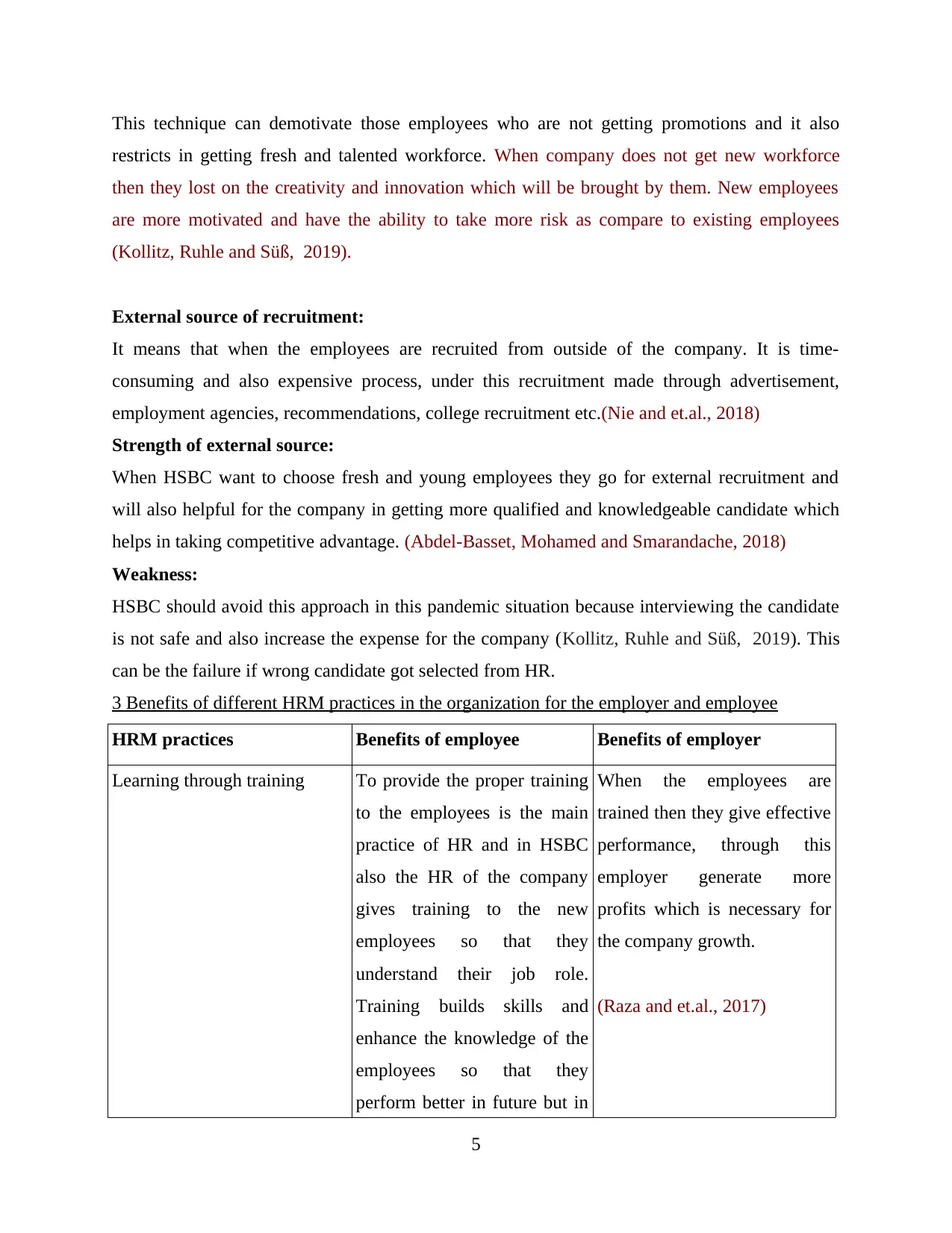
This technique can demotivate those employees who are not getting promotions and it also
restricts in getting fresh and talented workforce. When company does not get new workforce
then they lost on the creativity and innovation which will be brought by them. New employees
are more motivated and have the ability to take more risk as compare to existing employees
(Kollitz, Ruhle and Süß, 2019).
External source of recruitment:
It means that when the employees are recruited from outside of the company. It is time-
consuming and also expensive process, under this recruitment made through advertisement,
employment agencies, recommendations, college recruitment etc.(Nie and et.al., 2018)
Strength of external source:
When HSBC want to choose fresh and young employees they go for external recruitment and
will also helpful for the company in getting more qualified and knowledgeable candidate which
helps in taking competitive advantage. (Abdel-Basset, Mohamed and Smarandache, 2018)
Weakness:
HSBC should avoid this approach in this pandemic situation because interviewing the candidate
is not safe and also increase the expense for the company (Kollitz, Ruhle and Süß, 2019). This
can be the failure if wrong candidate got selected from HR.
3 Benefits of different HRM practices in the organization for the employer and employee
HRM practices Benefits of employee Benefits of employer
Learning through training To provide the proper training
to the employees is the main
practice of HR and in HSBC
also the HR of the company
gives training to the new
employees so that they
understand their job role.
Training builds skills and
enhance the knowledge of the
employees so that they
perform better in future but in
When the employees are
trained then they give effective
performance, through this
employer generate more
profits which is necessary for
the company growth.
(Raza and et.al., 2017)
5
restricts in getting fresh and talented workforce. When company does not get new workforce
then they lost on the creativity and innovation which will be brought by them. New employees
are more motivated and have the ability to take more risk as compare to existing employees
(Kollitz, Ruhle and Süß, 2019).
External source of recruitment:
It means that when the employees are recruited from outside of the company. It is time-
consuming and also expensive process, under this recruitment made through advertisement,
employment agencies, recommendations, college recruitment etc.(Nie and et.al., 2018)
Strength of external source:
When HSBC want to choose fresh and young employees they go for external recruitment and
will also helpful for the company in getting more qualified and knowledgeable candidate which
helps in taking competitive advantage. (Abdel-Basset, Mohamed and Smarandache, 2018)
Weakness:
HSBC should avoid this approach in this pandemic situation because interviewing the candidate
is not safe and also increase the expense for the company (Kollitz, Ruhle and Süß, 2019). This
can be the failure if wrong candidate got selected from HR.
3 Benefits of different HRM practices in the organization for the employer and employee
HRM practices Benefits of employee Benefits of employer
Learning through training To provide the proper training
to the employees is the main
practice of HR and in HSBC
also the HR of the company
gives training to the new
employees so that they
understand their job role.
Training builds skills and
enhance the knowledge of the
employees so that they
perform better in future but in
When the employees are
trained then they give effective
performance, through this
employer generate more
profits which is necessary for
the company growth.
(Raza and et.al., 2017)
5
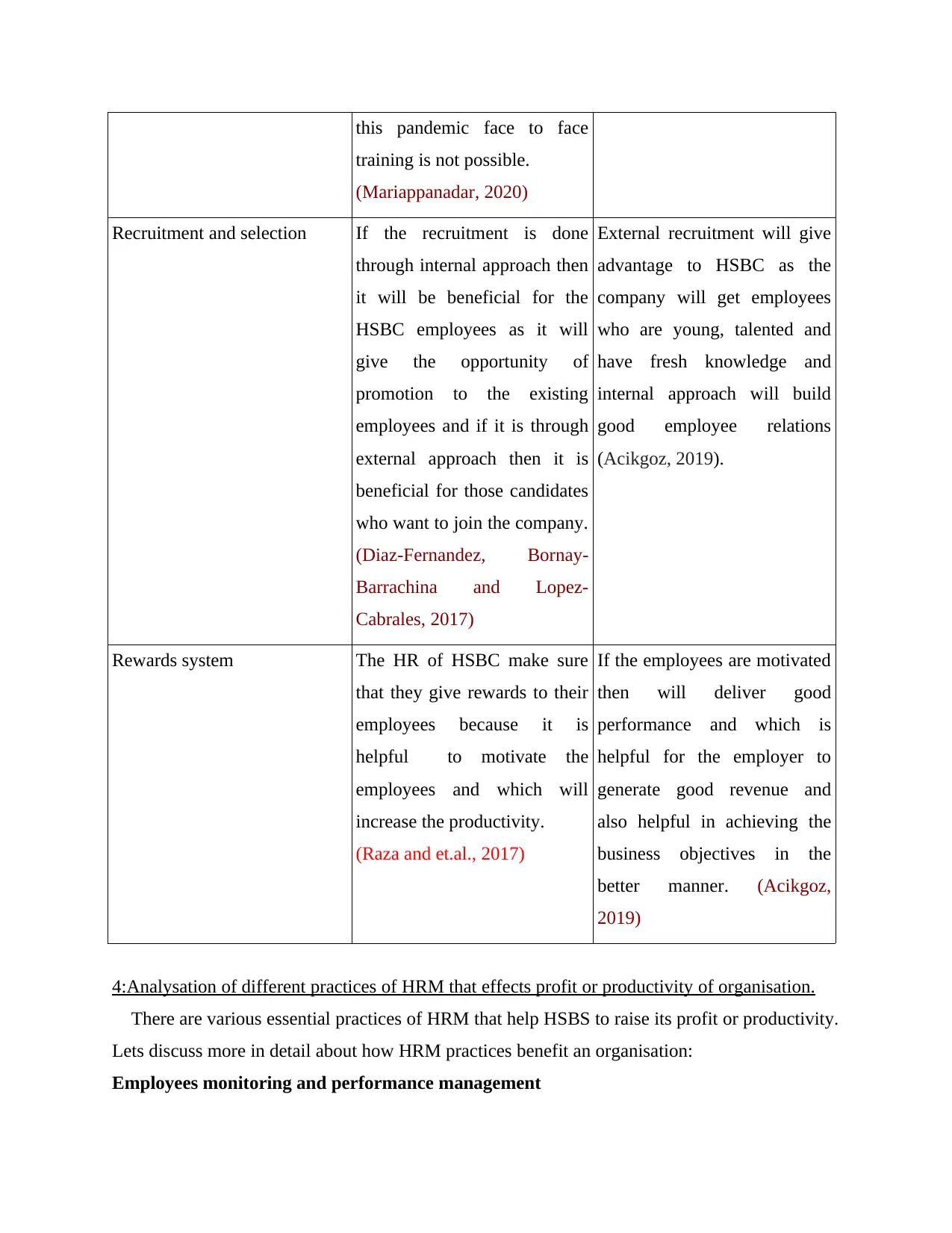
this pandemic face to face
training is not possible.
(Mariappanadar, 2020)
Recruitment and selection If the recruitment is done
through internal approach then
it will be beneficial for the
HSBC employees as it will
give the opportunity of
promotion to the existing
employees and if it is through
external approach then it is
beneficial for those candidates
who want to join the company.
(Diaz-Fernandez, Bornay-
Barrachina and Lopez-
Cabrales, 2017)
External recruitment will give
advantage to HSBC as the
company will get employees
who are young, talented and
have fresh knowledge and
internal approach will build
good employee relations
(Acikgoz, 2019).
Rewards system The HR of HSBC make sure
that they give rewards to their
employees because it is
helpful to motivate the
employees and which will
increase the productivity.
(Raza and et.al., 2017)
If the employees are motivated
then will deliver good
performance and which is
helpful for the employer to
generate good revenue and
also helpful in achieving the
business objectives in the
better manner. (Acikgoz,
2019)
4:Analysation of different practices of HRM that effects profit or productivity of organisation.
There are various essential practices of HRM that help HSBS to raise its profit or productivity.
Lets discuss more in detail about how HRM practices benefit an organisation:
Employees monitoring and performance management
training is not possible.
(Mariappanadar, 2020)
Recruitment and selection If the recruitment is done
through internal approach then
it will be beneficial for the
HSBC employees as it will
give the opportunity of
promotion to the existing
employees and if it is through
external approach then it is
beneficial for those candidates
who want to join the company.
(Diaz-Fernandez, Bornay-
Barrachina and Lopez-
Cabrales, 2017)
External recruitment will give
advantage to HSBC as the
company will get employees
who are young, talented and
have fresh knowledge and
internal approach will build
good employee relations
(Acikgoz, 2019).
Rewards system The HR of HSBC make sure
that they give rewards to their
employees because it is
helpful to motivate the
employees and which will
increase the productivity.
(Raza and et.al., 2017)
If the employees are motivated
then will deliver good
performance and which is
helpful for the employer to
generate good revenue and
also helpful in achieving the
business objectives in the
better manner. (Acikgoz,
2019)
4:Analysation of different practices of HRM that effects profit or productivity of organisation.
There are various essential practices of HRM that help HSBS to raise its profit or productivity.
Lets discuss more in detail about how HRM practices benefit an organisation:
Employees monitoring and performance management
⊘ This is a preview!⊘
Do you want full access?
Subscribe today to unlock all pages.

Trusted by 1+ million students worldwide
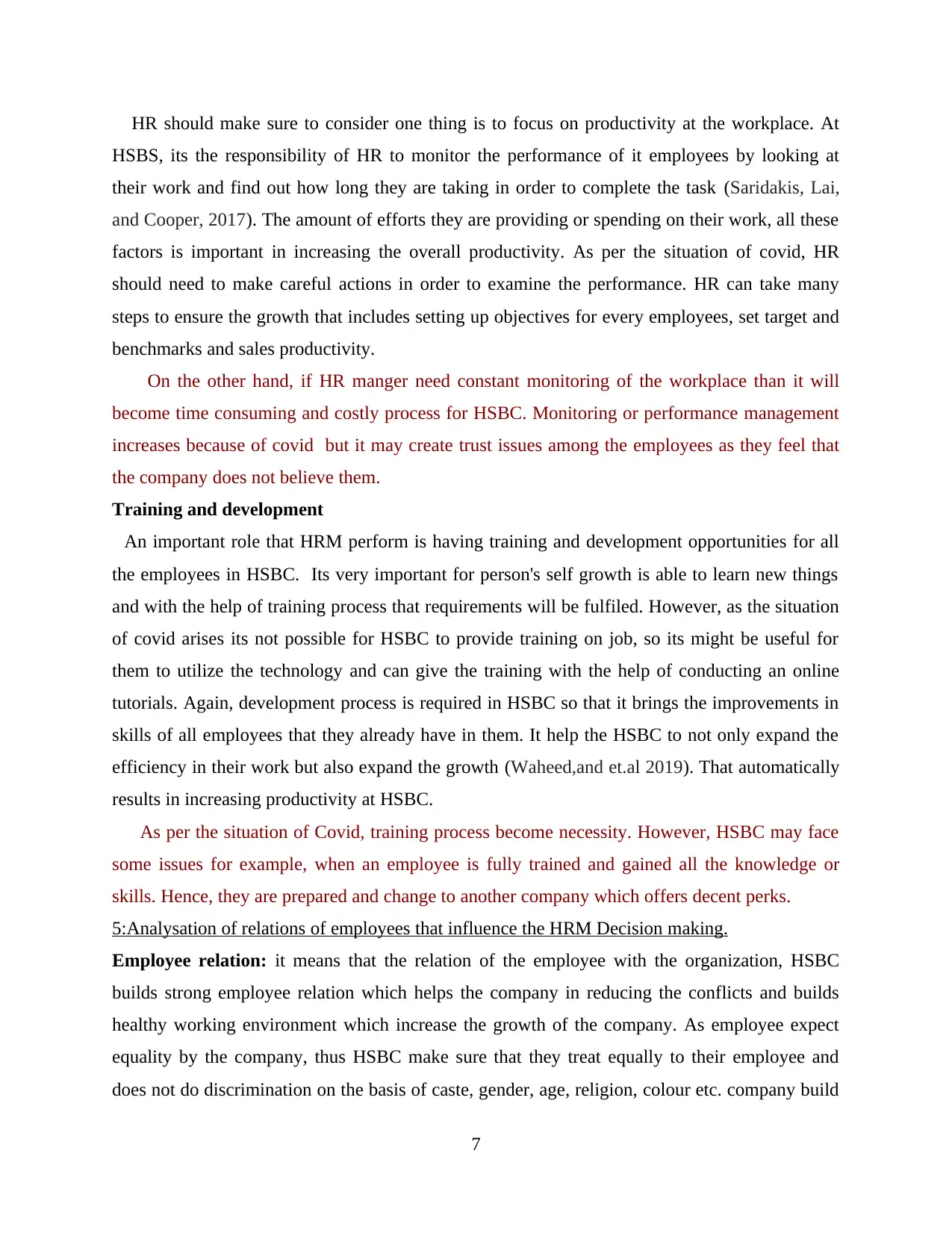
HR should make sure to consider one thing is to focus on productivity at the workplace. At
HSBS, its the responsibility of HR to monitor the performance of it employees by looking at
their work and find out how long they are taking in order to complete the task (Saridakis, Lai,
and Cooper, 2017). The amount of efforts they are providing or spending on their work, all these
factors is important in increasing the overall productivity. As per the situation of covid, HR
should need to make careful actions in order to examine the performance. HR can take many
steps to ensure the growth that includes setting up objectives for every employees, set target and
benchmarks and sales productivity.
On the other hand, if HR manger need constant monitoring of the workplace than it will
become time consuming and costly process for HSBC. Monitoring or performance management
increases because of covid but it may create trust issues among the employees as they feel that
the company does not believe them.
Training and development
An important role that HRM perform is having training and development opportunities for all
the employees in HSBC. Its very important for person's self growth is able to learn new things
and with the help of training process that requirements will be fulfiled. However, as the situation
of covid arises its not possible for HSBC to provide training on job, so its might be useful for
them to utilize the technology and can give the training with the help of conducting an online
tutorials. Again, development process is required in HSBC so that it brings the improvements in
skills of all employees that they already have in them. It help the HSBC to not only expand the
efficiency in their work but also expand the growth (Waheed,and et.al 2019). That automatically
results in increasing productivity at HSBC.
As per the situation of Covid, training process become necessity. However, HSBC may face
some issues for example, when an employee is fully trained and gained all the knowledge or
skills. Hence, they are prepared and change to another company which offers decent perks.
5:Analysation of relations of employees that influence the HRM Decision making.
Employee relation: it means that the relation of the employee with the organization, HSBC
builds strong employee relation which helps the company in reducing the conflicts and builds
healthy working environment which increase the growth of the company. As employee expect
equality by the company, thus HSBC make sure that they treat equally to their employee and
does not do discrimination on the basis of caste, gender, age, religion, colour etc. company build
7
HSBS, its the responsibility of HR to monitor the performance of it employees by looking at
their work and find out how long they are taking in order to complete the task (Saridakis, Lai,
and Cooper, 2017). The amount of efforts they are providing or spending on their work, all these
factors is important in increasing the overall productivity. As per the situation of covid, HR
should need to make careful actions in order to examine the performance. HR can take many
steps to ensure the growth that includes setting up objectives for every employees, set target and
benchmarks and sales productivity.
On the other hand, if HR manger need constant monitoring of the workplace than it will
become time consuming and costly process for HSBC. Monitoring or performance management
increases because of covid but it may create trust issues among the employees as they feel that
the company does not believe them.
Training and development
An important role that HRM perform is having training and development opportunities for all
the employees in HSBC. Its very important for person's self growth is able to learn new things
and with the help of training process that requirements will be fulfiled. However, as the situation
of covid arises its not possible for HSBC to provide training on job, so its might be useful for
them to utilize the technology and can give the training with the help of conducting an online
tutorials. Again, development process is required in HSBC so that it brings the improvements in
skills of all employees that they already have in them. It help the HSBC to not only expand the
efficiency in their work but also expand the growth (Waheed,and et.al 2019). That automatically
results in increasing productivity at HSBC.
As per the situation of Covid, training process become necessity. However, HSBC may face
some issues for example, when an employee is fully trained and gained all the knowledge or
skills. Hence, they are prepared and change to another company which offers decent perks.
5:Analysation of relations of employees that influence the HRM Decision making.
Employee relation: it means that the relation of the employee with the organization, HSBC
builds strong employee relation which helps the company in reducing the conflicts and builds
healthy working environment which increase the growth of the company. As employee expect
equality by the company, thus HSBC make sure that they treat equally to their employee and
does not do discrimination on the basis of caste, gender, age, religion, colour etc. company build
7
Paraphrase This Document
Need a fresh take? Get an instant paraphrase of this document with our AI Paraphraser
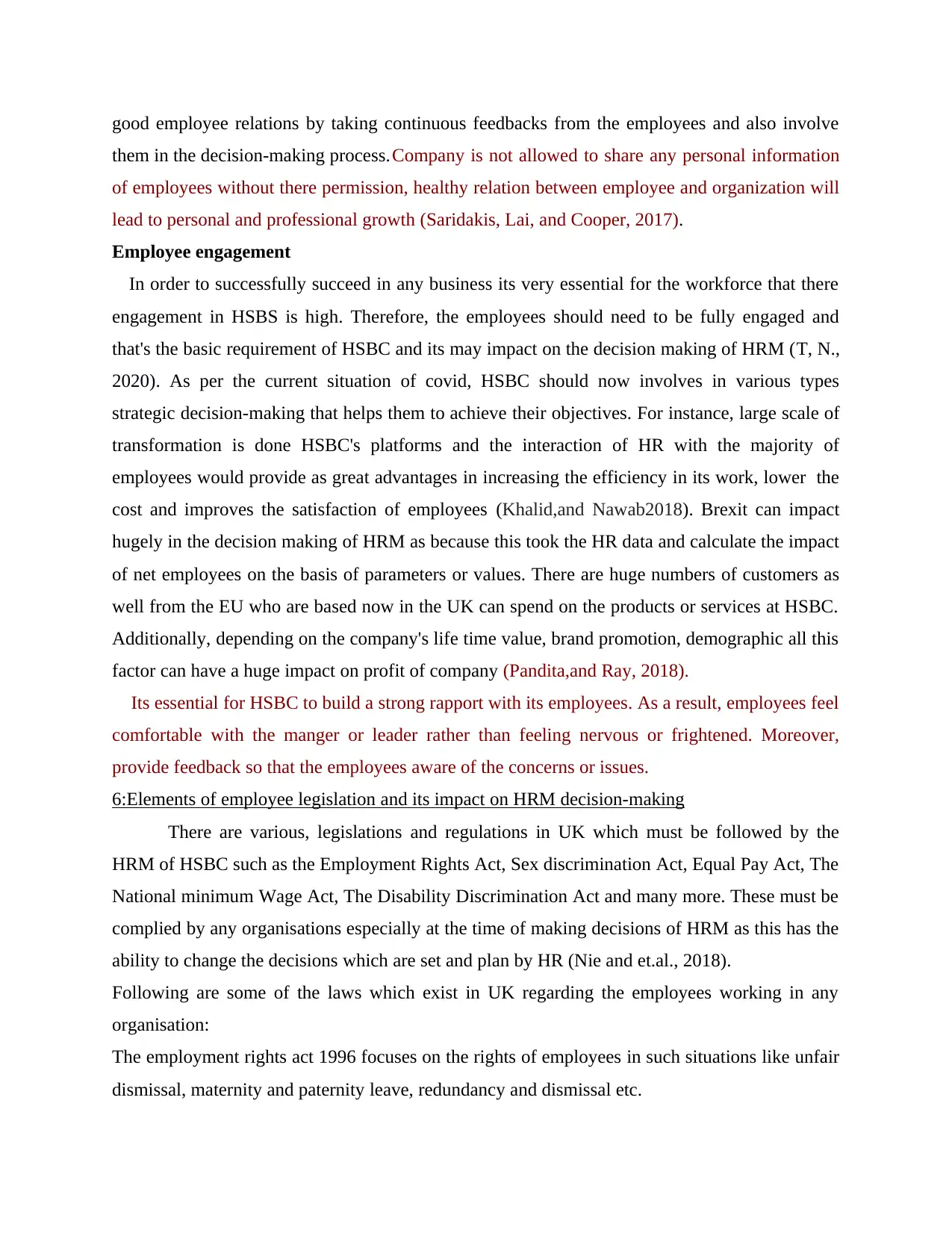
good employee relations by taking continuous feedbacks from the employees and also involve
them in the decision-making process.Company is not allowed to share any personal information
of employees without there permission, healthy relation between employee and organization will
lead to personal and professional growth (Saridakis, Lai, and Cooper, 2017).
Employee engagement
In order to successfully succeed in any business its very essential for the workforce that there
engagement in HSBS is high. Therefore, the employees should need to be fully engaged and
that's the basic requirement of HSBC and its may impact on the decision making of HRM (T, N.,
2020). As per the current situation of covid, HSBC should now involves in various types
strategic decision-making that helps them to achieve their objectives. For instance, large scale of
transformation is done HSBC's platforms and the interaction of HR with the majority of
employees would provide as great advantages in increasing the efficiency in its work, lower the
cost and improves the satisfaction of employees (Khalid,and Nawab2018). Brexit can impact
hugely in the decision making of HRM as because this took the HR data and calculate the impact
of net employees on the basis of parameters or values. There are huge numbers of customers as
well from the EU who are based now in the UK can spend on the products or services at HSBC.
Additionally, depending on the company's life time value, brand promotion, demographic all this
factor can have a huge impact on profit of company (Pandita,and Ray, 2018).
Its essential for HSBC to build a strong rapport with its employees. As a result, employees feel
comfortable with the manger or leader rather than feeling nervous or frightened. Moreover,
provide feedback so that the employees aware of the concerns or issues.
6:Elements of employee legislation and its impact on HRM decision-making
There are various, legislations and regulations in UK which must be followed by the
HRM of HSBC such as the Employment Rights Act, Sex discrimination Act, Equal Pay Act, The
National minimum Wage Act, The Disability Discrimination Act and many more. These must be
complied by any organisations especially at the time of making decisions of HRM as this has the
ability to change the decisions which are set and plan by HR (Nie and et.al., 2018).
Following are some of the laws which exist in UK regarding the employees working in any
organisation:
The employment rights act 1996 focuses on the rights of employees in such situations like unfair
dismissal, maternity and paternity leave, redundancy and dismissal etc.
them in the decision-making process.Company is not allowed to share any personal information
of employees without there permission, healthy relation between employee and organization will
lead to personal and professional growth (Saridakis, Lai, and Cooper, 2017).
Employee engagement
In order to successfully succeed in any business its very essential for the workforce that there
engagement in HSBS is high. Therefore, the employees should need to be fully engaged and
that's the basic requirement of HSBC and its may impact on the decision making of HRM (T, N.,
2020). As per the current situation of covid, HSBC should now involves in various types
strategic decision-making that helps them to achieve their objectives. For instance, large scale of
transformation is done HSBC's platforms and the interaction of HR with the majority of
employees would provide as great advantages in increasing the efficiency in its work, lower the
cost and improves the satisfaction of employees (Khalid,and Nawab2018). Brexit can impact
hugely in the decision making of HRM as because this took the HR data and calculate the impact
of net employees on the basis of parameters or values. There are huge numbers of customers as
well from the EU who are based now in the UK can spend on the products or services at HSBC.
Additionally, depending on the company's life time value, brand promotion, demographic all this
factor can have a huge impact on profit of company (Pandita,and Ray, 2018).
Its essential for HSBC to build a strong rapport with its employees. As a result, employees feel
comfortable with the manger or leader rather than feeling nervous or frightened. Moreover,
provide feedback so that the employees aware of the concerns or issues.
6:Elements of employee legislation and its impact on HRM decision-making
There are various, legislations and regulations in UK which must be followed by the
HRM of HSBC such as the Employment Rights Act, Sex discrimination Act, Equal Pay Act, The
National minimum Wage Act, The Disability Discrimination Act and many more. These must be
complied by any organisations especially at the time of making decisions of HRM as this has the
ability to change the decisions which are set and plan by HR (Nie and et.al., 2018).
Following are some of the laws which exist in UK regarding the employees working in any
organisation:
The employment rights act 1996 focuses on the rights of employees in such situations like unfair
dismissal, maternity and paternity leave, redundancy and dismissal etc.

The employment relations act 1999 helps in establishing rights at work for derecognition, trade
union recognition and industrial actions. (Nie and et.al., 2018)
The elements which are relevant to the employment legislations include the equal employment
opportunity, sexual harassment, affirmative action’s, wages and remuneration, working time
regulations, trade unions and other relationships of industry, social security, working conditions,
welfare, health and safety as well as special provisions for other groups and occupations
(Mawdsley and Lewis, 2017).
These elements in the legislation help the HRM of HSBC in regulating the payroll policies along
with other benefits plan and remuneration. This also affects the social security plans and the
special provisions which depend on the job nature and situations. The legislations of employment
also regulate the planning and scheduling of working time so that the decisions of HRM go right
leading to equality and fairness among the employees. (Ahammad, 2017)
7:Application of HRM practices
There are various practices of HRM such as recruitment and selection, training, providing
security to employees etc. Among all the practices the recruitment and selection is the most
important practice which can be illustrated from the view point of work in HSBC for the new
vacant position of the HR manager.
Rationale
The major logic behind the practice of recruitment and selection is hiring of the exact
skillful candidate and the best suited individuals for the post of HR manager by considering the
company policies, position purpose and the culture of the company (Richards and Sang, 2019).
Another reason is also putting the selected candidate in the right positions with the enough
responsibilities and authorities.
Job description
Job title: Human Resource manager
Company: HSBC holdings plc.
Qualifications: MBA in business administration or B.Tech. In Computer Science
Position: 1
Roles and Responsibilities:
9
union recognition and industrial actions. (Nie and et.al., 2018)
The elements which are relevant to the employment legislations include the equal employment
opportunity, sexual harassment, affirmative action’s, wages and remuneration, working time
regulations, trade unions and other relationships of industry, social security, working conditions,
welfare, health and safety as well as special provisions for other groups and occupations
(Mawdsley and Lewis, 2017).
These elements in the legislation help the HRM of HSBC in regulating the payroll policies along
with other benefits plan and remuneration. This also affects the social security plans and the
special provisions which depend on the job nature and situations. The legislations of employment
also regulate the planning and scheduling of working time so that the decisions of HRM go right
leading to equality and fairness among the employees. (Ahammad, 2017)
7:Application of HRM practices
There are various practices of HRM such as recruitment and selection, training, providing
security to employees etc. Among all the practices the recruitment and selection is the most
important practice which can be illustrated from the view point of work in HSBC for the new
vacant position of the HR manager.
Rationale
The major logic behind the practice of recruitment and selection is hiring of the exact
skillful candidate and the best suited individuals for the post of HR manager by considering the
company policies, position purpose and the culture of the company (Richards and Sang, 2019).
Another reason is also putting the selected candidate in the right positions with the enough
responsibilities and authorities.
Job description
Job title: Human Resource manager
Company: HSBC holdings plc.
Qualifications: MBA in business administration or B.Tech. In Computer Science
Position: 1
Roles and Responsibilities:
9
⊘ This is a preview!⊘
Do you want full access?
Subscribe today to unlock all pages.

Trusted by 1+ million students worldwide
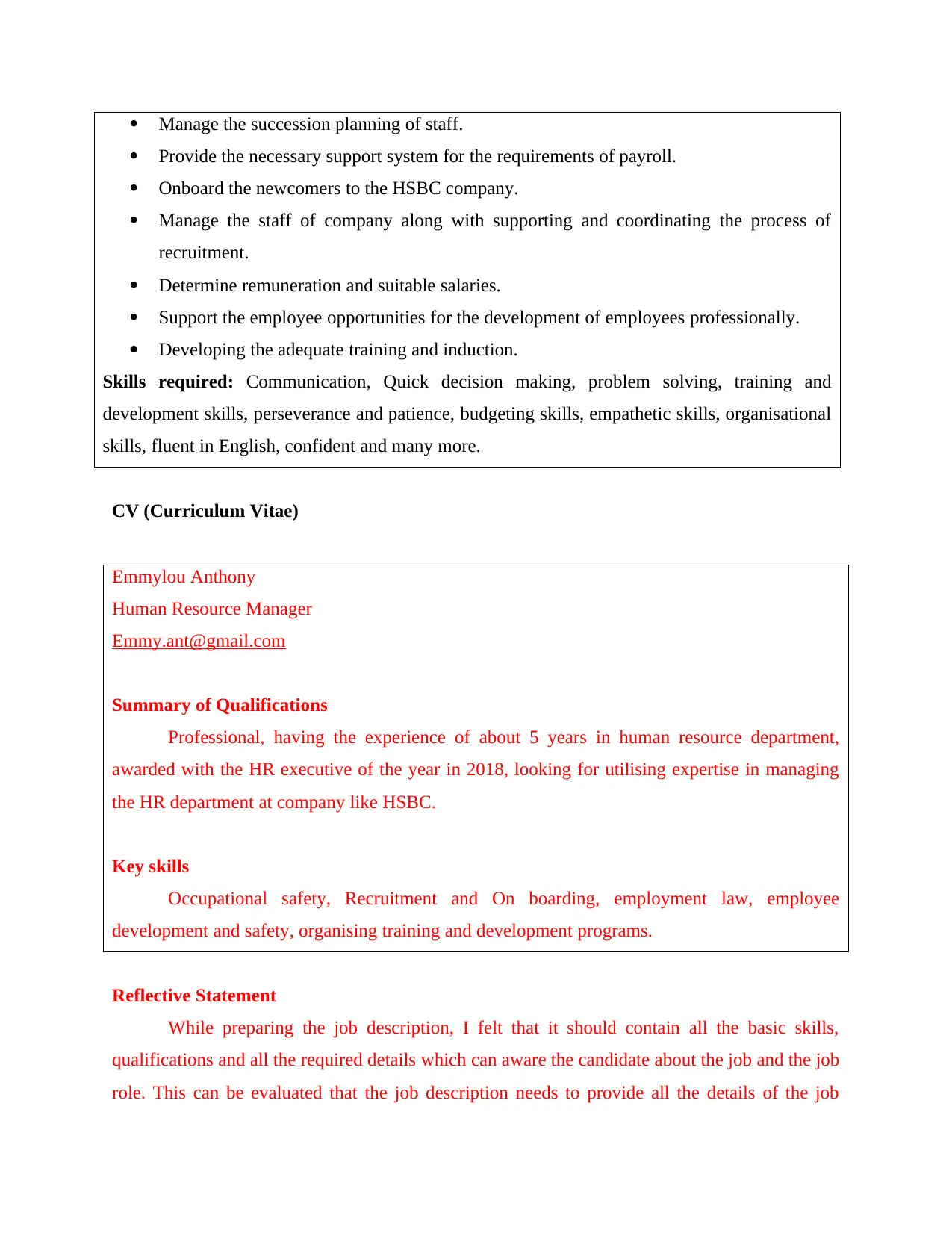
Manage the succession planning of staff.
Provide the necessary support system for the requirements of payroll.
Onboard the newcomers to the HSBC company.
Manage the staff of company along with supporting and coordinating the process of
recruitment.
Determine remuneration and suitable salaries.
Support the employee opportunities for the development of employees professionally.
Developing the adequate training and induction.
Skills required: Communication, Quick decision making, problem solving, training and
development skills, perseverance and patience, budgeting skills, empathetic skills, organisational
skills, fluent in English, confident and many more.
CV (Curriculum Vitae)
Emmylou Anthony
Human Resource Manager
Emmy.ant@gmail.com
Summary of Qualifications
Professional, having the experience of about 5 years in human resource department,
awarded with the HR executive of the year in 2018, looking for utilising expertise in managing
the HR department at company like HSBC.
Key skills
Occupational safety, Recruitment and On boarding, employment law, employee
development and safety, organising training and development programs.
Reflective Statement
While preparing the job description, I felt that it should contain all the basic skills,
qualifications and all the required details which can aware the candidate about the job and the job
role. This can be evaluated that the job description needs to provide all the details of the job
Provide the necessary support system for the requirements of payroll.
Onboard the newcomers to the HSBC company.
Manage the staff of company along with supporting and coordinating the process of
recruitment.
Determine remuneration and suitable salaries.
Support the employee opportunities for the development of employees professionally.
Developing the adequate training and induction.
Skills required: Communication, Quick decision making, problem solving, training and
development skills, perseverance and patience, budgeting skills, empathetic skills, organisational
skills, fluent in English, confident and many more.
CV (Curriculum Vitae)
Emmylou Anthony
Human Resource Manager
Emmy.ant@gmail.com
Summary of Qualifications
Professional, having the experience of about 5 years in human resource department,
awarded with the HR executive of the year in 2018, looking for utilising expertise in managing
the HR department at company like HSBC.
Key skills
Occupational safety, Recruitment and On boarding, employment law, employee
development and safety, organising training and development programs.
Reflective Statement
While preparing the job description, I felt that it should contain all the basic skills,
qualifications and all the required details which can aware the candidate about the job and the job
role. This can be evaluated that the job description needs to provide all the details of the job
Paraphrase This Document
Need a fresh take? Get an instant paraphrase of this document with our AI Paraphraser

position. It helps in knowing about the work which needs to be done at the position. It can also
be analysed that the job description must be very accurate as it also impacts the good will and the
status of the company and also it must not contain any grammatical mistakes. I could have also
added the overview as well as purpose of the job description.
CONCLUSION
The report shed light on the HRM in HSBC Company. It started with explaining the purpose and
functions of HRM along with mentioning the strengths and weaknesses of recruitment and
selection methods. The benefits of HRM practices were also highlighted along with describing
the effectiveness of HRM practices. The report also focussed on the significance of employee
relations and the key elements of employee legislation and the application of HRM practice of
recruitment and selection.
REFERENCES
Books and journals
Abdel-Basset, M., Mohamed, M. and Smarandache, F., 2018. An extension of neutrosophic
AHP–SWOT analysis for strategic planning and decision-making. Symmetry, 10(4),
p.116.
Acikgoz, Y., 2019. Employee recruitment and job search: Towards a multi-level
integration. Human resource management review. 29(1). pp.1-13.
Ahammad, T., 2017. Personnel management to human resource management (HRM): How
HRM functions. Journal of Modern Accounting and Auditing. 13(9). pp.412-420.
Aust, I., Matthews, B. and Muller-Camen, M., 2020. Common Good HRM: A paradigm shift in
Sustainable HRM?. Human Resource Management Review.30(3). p.100705.
11
be analysed that the job description must be very accurate as it also impacts the good will and the
status of the company and also it must not contain any grammatical mistakes. I could have also
added the overview as well as purpose of the job description.
CONCLUSION
The report shed light on the HRM in HSBC Company. It started with explaining the purpose and
functions of HRM along with mentioning the strengths and weaknesses of recruitment and
selection methods. The benefits of HRM practices were also highlighted along with describing
the effectiveness of HRM practices. The report also focussed on the significance of employee
relations and the key elements of employee legislation and the application of HRM practice of
recruitment and selection.
REFERENCES
Books and journals
Abdel-Basset, M., Mohamed, M. and Smarandache, F., 2018. An extension of neutrosophic
AHP–SWOT analysis for strategic planning and decision-making. Symmetry, 10(4),
p.116.
Acikgoz, Y., 2019. Employee recruitment and job search: Towards a multi-level
integration. Human resource management review. 29(1). pp.1-13.
Ahammad, T., 2017. Personnel management to human resource management (HRM): How
HRM functions. Journal of Modern Accounting and Auditing. 13(9). pp.412-420.
Aust, I., Matthews, B. and Muller-Camen, M., 2020. Common Good HRM: A paradigm shift in
Sustainable HRM?. Human Resource Management Review.30(3). p.100705.
11
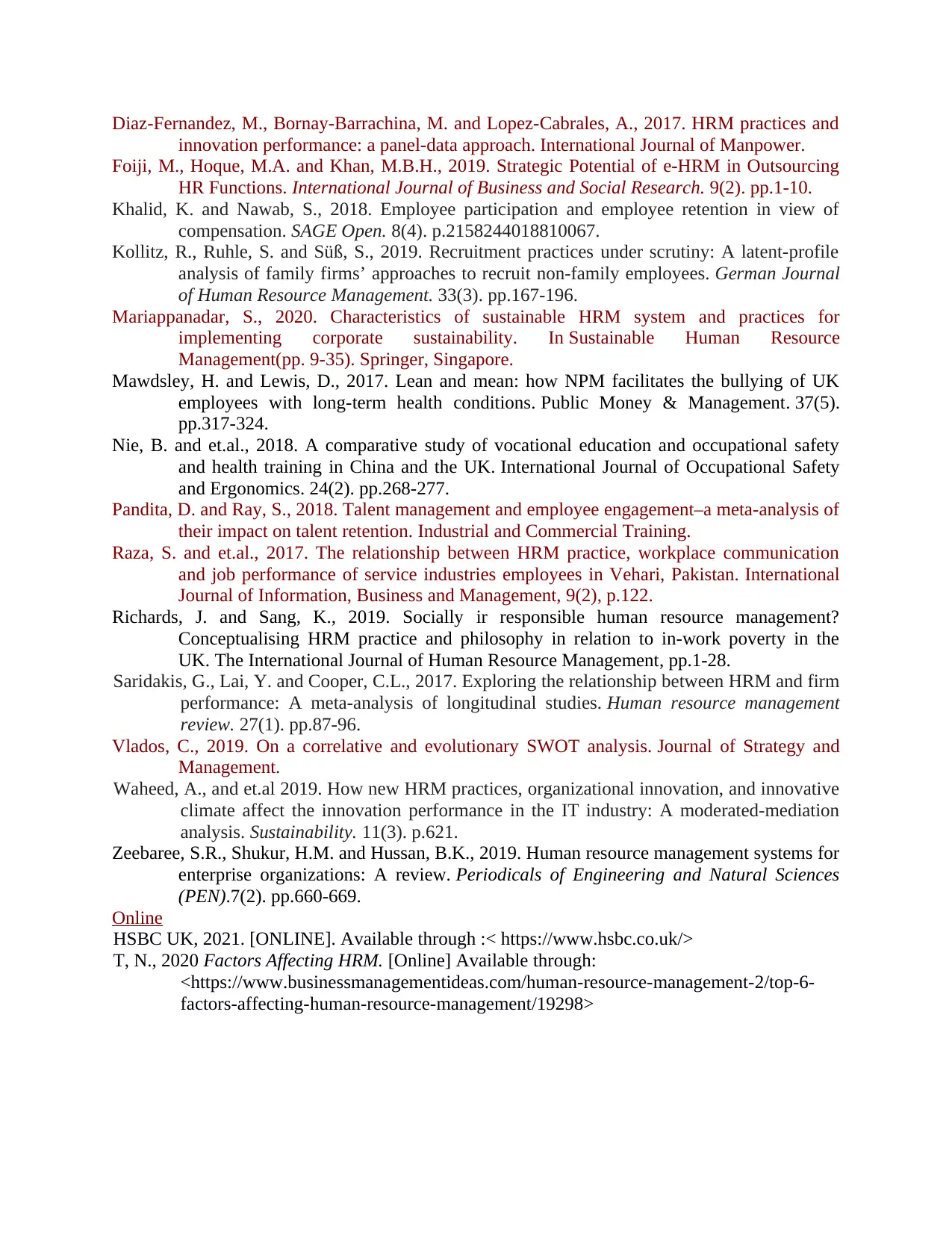
Diaz-Fernandez, M., Bornay-Barrachina, M. and Lopez-Cabrales, A., 2017. HRM practices and
innovation performance: a panel-data approach. International Journal of Manpower.
Foiji, M., Hoque, M.A. and Khan, M.B.H., 2019. Strategic Potential of e-HRM in Outsourcing
HR Functions. International Journal of Business and Social Research. 9(2). pp.1-10.
Khalid, K. and Nawab, S., 2018. Employee participation and employee retention in view of
compensation. SAGE Open. 8(4). p.2158244018810067.
Kollitz, R., Ruhle, S. and Süß, S., 2019. Recruitment practices under scrutiny: A latent-profile
analysis of family firms’ approaches to recruit non-family employees. German Journal
of Human Resource Management. 33(3). pp.167-196.
Mariappanadar, S., 2020. Characteristics of sustainable HRM system and practices for
implementing corporate sustainability. In Sustainable Human Resource
Management(pp. 9-35). Springer, Singapore.
Mawdsley, H. and Lewis, D., 2017. Lean and mean: how NPM facilitates the bullying of UK
employees with long-term health conditions. Public Money & Management. 37(5).
pp.317-324.
Nie, B. and et.al., 2018. A comparative study of vocational education and occupational safety
and health training in China and the UK. International Journal of Occupational Safety
and Ergonomics. 24(2). pp.268-277.
Pandita, D. and Ray, S., 2018. Talent management and employee engagement–a meta-analysis of
their impact on talent retention. Industrial and Commercial Training.
Raza, S. and et.al., 2017. The relationship between HRM practice, workplace communication
and job performance of service industries employees in Vehari, Pakistan. International
Journal of Information, Business and Management, 9(2), p.122.
Richards, J. and Sang, K., 2019. Socially ir responsible human resource management?
Conceptualising HRM practice and philosophy in relation to in-work poverty in the
UK. The International Journal of Human Resource Management, pp.1-28.
Saridakis, G., Lai, Y. and Cooper, C.L., 2017. Exploring the relationship between HRM and firm
performance: A meta-analysis of longitudinal studies. Human resource management
review. 27(1). pp.87-96.
Vlados, C., 2019. On a correlative and evolutionary SWOT analysis. Journal of Strategy and
Management.
Waheed, A., and et.al 2019. How new HRM practices, organizational innovation, and innovative
climate affect the innovation performance in the IT industry: A moderated-mediation
analysis. Sustainability. 11(3). p.621.
Zeebaree, S.R., Shukur, H.M. and Hussan, B.K., 2019. Human resource management systems for
enterprise organizations: A review. Periodicals of Engineering and Natural Sciences
(PEN).7(2). pp.660-669.
Online
HSBC UK, 2021. [ONLINE]. Available through :< https://www.hsbc.co.uk/>
T, N., 2020 Factors Affecting HRM. [Online] Available through:
<https://www.businessmanagementideas.com/human-resource-management-2/top-6-
factors-affecting-human-resource-management/19298>
innovation performance: a panel-data approach. International Journal of Manpower.
Foiji, M., Hoque, M.A. and Khan, M.B.H., 2019. Strategic Potential of e-HRM in Outsourcing
HR Functions. International Journal of Business and Social Research. 9(2). pp.1-10.
Khalid, K. and Nawab, S., 2018. Employee participation and employee retention in view of
compensation. SAGE Open. 8(4). p.2158244018810067.
Kollitz, R., Ruhle, S. and Süß, S., 2019. Recruitment practices under scrutiny: A latent-profile
analysis of family firms’ approaches to recruit non-family employees. German Journal
of Human Resource Management. 33(3). pp.167-196.
Mariappanadar, S., 2020. Characteristics of sustainable HRM system and practices for
implementing corporate sustainability. In Sustainable Human Resource
Management(pp. 9-35). Springer, Singapore.
Mawdsley, H. and Lewis, D., 2017. Lean and mean: how NPM facilitates the bullying of UK
employees with long-term health conditions. Public Money & Management. 37(5).
pp.317-324.
Nie, B. and et.al., 2018. A comparative study of vocational education and occupational safety
and health training in China and the UK. International Journal of Occupational Safety
and Ergonomics. 24(2). pp.268-277.
Pandita, D. and Ray, S., 2018. Talent management and employee engagement–a meta-analysis of
their impact on talent retention. Industrial and Commercial Training.
Raza, S. and et.al., 2017. The relationship between HRM practice, workplace communication
and job performance of service industries employees in Vehari, Pakistan. International
Journal of Information, Business and Management, 9(2), p.122.
Richards, J. and Sang, K., 2019. Socially ir responsible human resource management?
Conceptualising HRM practice and philosophy in relation to in-work poverty in the
UK. The International Journal of Human Resource Management, pp.1-28.
Saridakis, G., Lai, Y. and Cooper, C.L., 2017. Exploring the relationship between HRM and firm
performance: A meta-analysis of longitudinal studies. Human resource management
review. 27(1). pp.87-96.
Vlados, C., 2019. On a correlative and evolutionary SWOT analysis. Journal of Strategy and
Management.
Waheed, A., and et.al 2019. How new HRM practices, organizational innovation, and innovative
climate affect the innovation performance in the IT industry: A moderated-mediation
analysis. Sustainability. 11(3). p.621.
Zeebaree, S.R., Shukur, H.M. and Hussan, B.K., 2019. Human resource management systems for
enterprise organizations: A review. Periodicals of Engineering and Natural Sciences
(PEN).7(2). pp.660-669.
Online
HSBC UK, 2021. [ONLINE]. Available through :< https://www.hsbc.co.uk/>
T, N., 2020 Factors Affecting HRM. [Online] Available through:
<https://www.businessmanagementideas.com/human-resource-management-2/top-6-
factors-affecting-human-resource-management/19298>
⊘ This is a preview!⊘
Do you want full access?
Subscribe today to unlock all pages.

Trusted by 1+ million students worldwide
1 out of 13
Related Documents
Your All-in-One AI-Powered Toolkit for Academic Success.
+13062052269
info@desklib.com
Available 24*7 on WhatsApp / Email
![[object Object]](/_next/static/media/star-bottom.7253800d.svg)
Unlock your academic potential
Copyright © 2020–2025 A2Z Services. All Rights Reserved. Developed and managed by ZUCOL.


